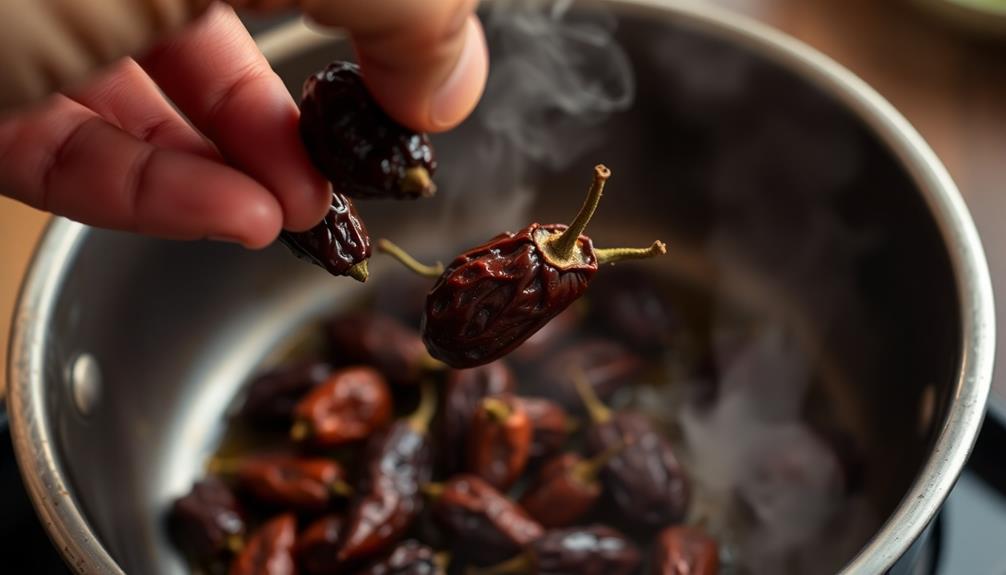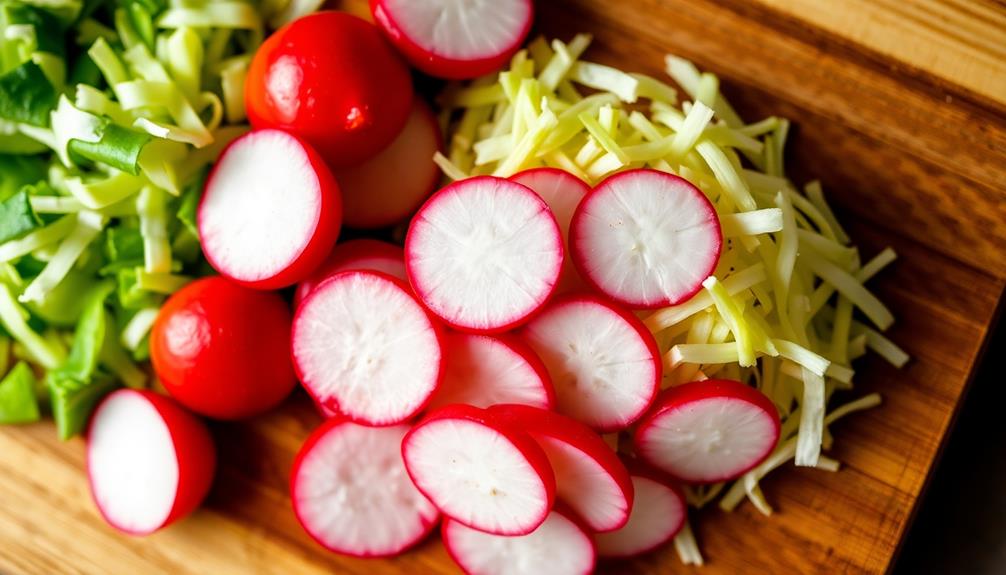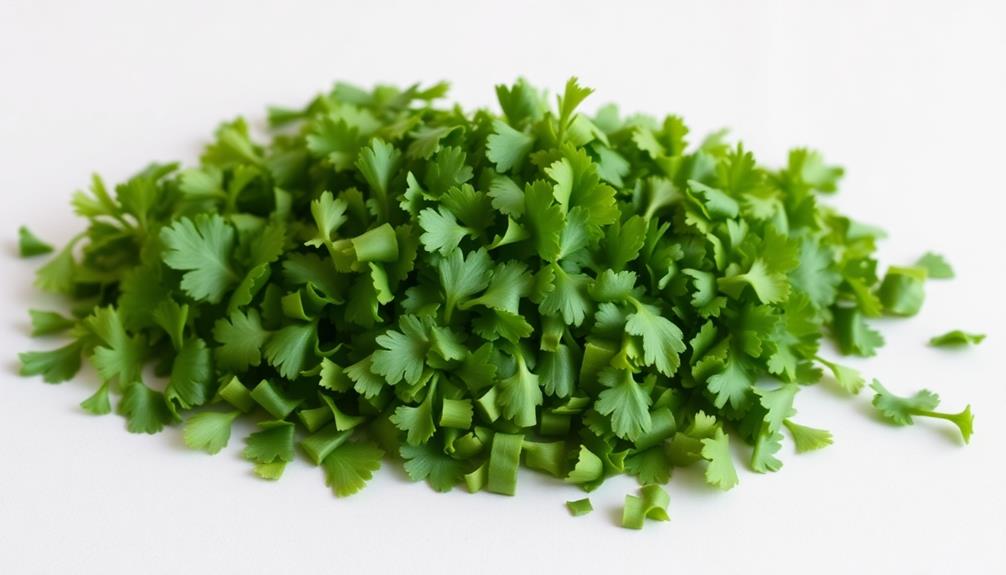Pozole is a mouthwatering Mexican stew that'll take your tastebuds on an incredible journey! Its origins trace back to the Aztecs, who used to make it with hominy, chili peppers, and meats during special ceremonies. Over time, it's evolved with Spanish influences, now featuring tender pork, aromatic spices, and a vibrant broth. You'll find all sorts of delicious toppings like crunchy cabbage, zesty radishes, and fresh cilantro to really make each bite pop. Pozole is a beloved dish that brings families together – and if you keep reading, you'll discover even more about this comforting cultural gem. Another popular variation of pozole is the white pozole, which uses chicken instead of pork and includes a flavorful broth made with tomatillos and green chilies. Regardless of the variation, pozole is often enjoyed with a side of tostadas or tortillas for dipping and savoring every last drop of the delicious stew. If you’re a fan of Mexican cuisine, you might also want to try the veracruzana fish recipe, a delightful seafood dish hailing from the Gulf Coast region of Mexico.
Key Takeaways
Key Points:
- Pozole is a traditional Mexican stew with origins in pre-Hispanic times, initially prepared by the Aztec people using hominy, chili peppers, and meats.
- The dish has evolved with Spanish colonization, incorporating pork and garnishes like lettuce and lime, resulting in various regional variations.
- The key ingredient in pozole is hominy, which provides a unique texture and flavor, while the dish is commonly enjoyed as a special occasion or weekend meal.
- The cooking process involves soaking hominy overnight, cooking pork in broth, adding dried chiles, and incorporating fresh vegetables like cabbage and radish.
- Pozole holds cultural significance, symbolizing unity and togetherness, and is often featured in festive celebrations and family gatherings in Mexico.
History
Pozole, a traditional Mexican stew, has a rich history that dates back to pre-Hispanic times. The dish's origins can be traced to the Aztec people, who'd prepare a hearty soup made with hominy, chili peppers, and various meats.
This nourishing meal was often served during important ceremonies and celebrations, as it was believed to have spiritual and medicinal properties.
As Spanish colonizers arrived in the 16th century, the recipe evolved, with the addition of new ingredients like pork and garnishes like shredded lettuce, radishes, and lime.
Over the centuries, different regions of Mexico have developed their own unique variations of pozole, each with its own distinct flavors and ingredients.
Today, pozole remains a beloved and iconic dish in Mexican cuisine, bringing families and communities together over a warm, comforting bowl.
Whether enjoying it on a chilly day or as part of a festive gathering, this ancient dish continues to nourish the body and soul.
Recipe
Pozole is a beloved Mexican stew that features hominy, a key ingredient that gives the dish its distinctive texture and flavor. This hearty and comforting meal is often enjoyed as a weekend or special occasion dish, but it can be easily prepared at home with a few simple steps.
The origins of pozole can be traced back to pre-Columbian Mesoamerican cuisine, where it was a ceremonial dish made with dried maize and meat. Over time, the recipe has evolved, and modern versions incorporate a variety of proteins, vegetables, and seasonings that reflect the diverse regional cuisines of Mexico.
- 2 lbs boneless pork shoulder, cut into 1-inch cubes
- 1 large white onion, diced
- 4 cloves garlic, minced
- 2 tablespoons vegetable oil
- 2 tablespoons ground cumin
- 2 tablespoons dried oregano
- 1 teaspoon chili powder
- 1 teaspoon ground coriander
- 2 (15 oz) cans hominy, drained and rinsed
- 6 cups chicken or pork broth
- Salt and pepper to taste
In a large pot or Dutch oven, heat the vegetable oil over medium-high heat. Add the pork cubes and brown them on all sides, about 5-7 minutes. Remove the pork from the pot and set aside.
Add the onion and garlic to the pot and sauté until softened and fragrant, about 3-4 minutes. Return the pork to the pot and stir in the cumin, oregano, chili powder, and coriander. Pour in the broth and hominy, and season with salt and pepper.
Bring the mixture to a boil, then reduce the heat and let it simmer for 45 minutes to 1 hour, or until the pork is tender and the flavors have melded.
When serving, offer a variety of toppings such as shredded cabbage, diced avocado, radishes, lime wedges, and chopped cilantro. This allows each diner to customize their pozole to their liking.
Enjoy this hearty and comforting dish with family and friends, and don't be afraid to experiment with different proteins or vegetable additions to make it your own.
Cooking Steps
First, you'll need to soak the hominy in water overnight to soften it up.
Next, cook the pork in broth until it's nice and tender.
Then, add some dried chiles to give it a little kick.
Don't forget the cabbage and radish – they'll add a fresh crunch.
Step 1. Soak Hominy in Water Overnight

The first step in preparing pozole is to soak the hominy in water overnight. Hominy is a special type of dried corn that's been treated with an alkali, giving it a unique, chewy texture.
By letting the hominy soak, you'll help soften it up and make it easier to cook. Simply place the dried hominy in a large bowl and cover it with plenty of water. Make sure the hominy is fully submerged, as it will expand as it soaks.
Then, just let the bowl sit on your kitchen counter overnight. The long soak will do all the work for you, transforming the hard kernels into plump, tender pieces ready for the next step.
In the morning, you'll notice the hominy has absorbed a lot of the water and grown in size. Drain the hominy well, discarding the soaking liquid.
Now your pozole base is all set to be cooked into a delicious, hearty stew. Wasn't that easy?
Step 2. Cook Pork in Broth

With the soaked hominy ready, you can now start cooking the pork for your pozole. In a large pot, pour in some chicken broth and bring it to a gentle simmer.
Carefully add the pork chunks and let them cook, stirring occasionally, until they're nice and tender, about 30 minutes.
Once the pork is cooked through, use a slotted spoon to transfer the pieces to a cutting board. Shred the pork into bite-sized strips using two forks. Mmm, can you already smell the delicious aroma?
Now, return the shredded pork to the simmering broth. Throw in some oregano, cumin, and a dash of chili powder to give your pozole a real flavor boost. Let everything mingle together for about 10 more minutes, allowing the spices to infuse the broth.
Your pozole is almost ready! The pork should be tender and the broth should be rich and flavorful. Get ready to ladle up some of this hearty, comforting goodness.
Step 3. Add Dried Chiles

Add the dried chiles to the simmering broth. You'll see them slowly unfurling, releasing their rich, smoky aroma. Grab a couple with a spoon and give them a gentle squeeze – you'll feel the heat radiating from them. Toss them right into the pot and let them steep, infusing the broth with their bold, earthy flavor.
Next, grab a ladle and take a little taste. Mmm, can you feel that tingle on your tongue? The chiles add just the right amount of spice to balance out the hearty pork and hominy. Keep adding them a little at a time until you reach your desired level of heat. Remember, you can always add more, but it's tricky to tone it down once it's too spicy!
As the chiles simmer, they'll turn the broth a deep, vibrant red. Yum, just looking at it makes your mouth water, doesn't it? Get ready for a flavor explosion in every bite!
Step 4. Add Cabbage and Radish

As the bold, earthy flavors of the dried chiles permeate the broth, it's time to add a pop of color and crunch with some fresh cabbage and radish.
You'll want to shred or thinly slice about 2 cups of crisp green cabbage and a handful of bright, crunchy radish slices. Carefully stir them into the simmering pot – the cool, peppery radish and the sweet, mild cabbage will provide a delightful contrast to the spicy and savory pozole.
The cabbage will soften slightly, while the radish will retain its refreshing bite. Soon, the vibrant vegetables will infuse the broth with their lively flavors, creating a truly well-rounded and satisfying pozole.
Don't forget to ladle up generous servings, making sure to scoop up plenty of the tasty toppings in each bowl. The pozole is really coming together now, and you're one step closer to enjoying this comforting and flavorful Mexican classic.
Step 5. Garnish With Chopped Cilantro

Finally, grab a bunch of fresh cilantro and roughly chop it. This bright, fragrant herb is the perfect finishing touch for your delicious pozole. Sprinkle the chopped cilantro over the top of your steaming bowl, letting the aroma waft up and tantalize your senses.
The vibrant green leaves add a lovely pop of color and a burst of flavor that complements the rich broth and tender hominy. As you take your first bite, you'll savor the way the cilantro's slightly citrusy taste mingles with the other ingredients.
The crunchy radish and cool cabbage provide a refreshing contrast to the warm, comforting pozole. Every spoonful is a delightful explosion of textures and flavors.
Garnishing your pozole with chopped cilantro is the perfect way to elevate this traditional Mexican dish. The fresh herb elevates the overall experience, making each bite more enjoyable and memorable.
Dig in and experience the perfect harmony of flavors in every delicious mouthful.
Final Thoughts
Pozole is a comforting and flavorful Mexican stew that's well worth the effort of preparing. After all that hard work, you can sit back, relax, and enjoy this delicious dish with your loved ones.
The tender pork, the hominy, and the bold flavors come together in a bowl that's truly satisfying.
Don't forget to garnish your pozole with all the tasty toppings – a sprinkle of chopped cilantro, a squeeze of lime, some crispy radishes, and a dollop of cool, creamy avocado. These fresh additions really make the dish pop with color and texture.
You can even get the whole family involved in the process, with everyone picking their favorite garnishes.
Pozole is the kind of meal that brings people together, so savor every bite and enjoy this comforting Mexican classic. Your taste buds will thank you!
Frequently Asked Questions
What Makes Pozole Different From Other Mexican Stews?
What sets this Mexican stew apart is its distinct broth, made with dried chiles and hominy. You'll find it has a unique flavor and texture compared to other hearty Latin American stews.
How Long Does It Take to Make Authentic Pozole?
It typically takes 2-3 hours to make authentic pozole, depending on the recipe and cooking method. The long simmering process allows the flavors to meld and the pork to become tender and flavorful.
Can I Use Canned Hominy Instead of Dried?
You can certainly use canned hominy instead of dried, but it won't have the same depth of flavor. The cooking time will be significantly reduced, but the texture and overall taste may not be as authentic.
Is Pozole Suitable for Vegetarians or Vegans?
Sure, pozole can be made suitable for vegetarians or vegans. You'll need to skip the traditional pork and use vegetable broth instead. With a few simple substitutions, you can enjoy this flavorful stew without animal products.
What Are the Traditional Garnishes for Pozole?
When it comes to traditional pozole, the typical garnishes include shredded cabbage, radishes, diced onion, lime wedges, oregano, and crispy tortilla chips. These toppings add freshness, crunch, and bright flavors to this flavorful Mexican stew.










